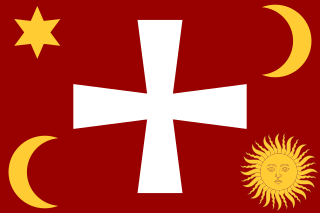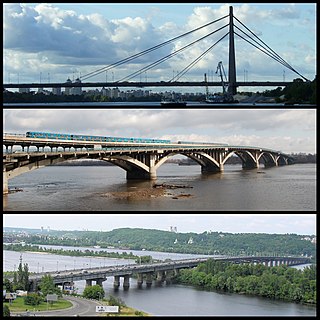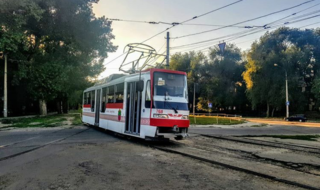
The Zaporozhian Sich was a semi-autonomous polity and proto-state of Cossacks that existed between the 16th to 18th centuries, including as an autonomous stratocratic state within the Cossack Hetmanate for over a hundred years, centred around the region now home to the Kakhovka Reservoir and spanning the lower Dnieper river in Ukraine. In different periods the area came under the sovereignty of the Polish–Lithuanian Commonwealth, the Ottoman Empire, the Tsardom of Russia, and the Russian Empire.

Zaporizhzhia or Zaporozhye, until 1921 known as Aleksandrovsk or Oleksandrivsk, is a city in southeast Ukraine, situated on the banks of the Dnieper River. It is the administrative centre of Zaporizhzhia Oblast. Zaporizhzhia has a population of 710,052.

The Dnieper Hydroelectric Station, also known as Dnipro Dam, in the city of Zaporizhzhia, Ukraine, is the largest hydroelectric power station on the Dnieper river. It is the fifth step of the Dnieper cascade of hydroelectric stations that provides electric power for the Donets–Kryvyi Rih Industrial region. The Dnieper Reservoir stretches 129 kilometres (80 mi) upstream to near Dnipro city.
Khortytsia is the largest island on the Dnieper river, and is 12.5 km (7.77 mi) long and up to 2.5 km (1.55 mi) wide. The island forms part of the Khortytsia National Park. This historic site is located within the city limits of Zaporizhzhia, Ukraine.

Kyiv, historically situated on the right bank of the Dnieper River, now covers both banks of the river whose width, as it flows through the city, reaches several hundred metres. Additionally, several tributaries join the Dnieper inside or just north or south of the historic city. Currently there are eight bridges spanning across the river and a few dozen bridges across the canals and Dnieper tributaries.

Zaporizhzhia International Airport is the international airport that serves Zaporizhzhia, Ukraine, one of three airfields around the city. The aircraft engine factory Motor Sich has its base here. In May 2020, the airport was extended with a new terminal with a capacity of 400 passengers. The airport is also home to the Zaporizhzhia State Aircraft Repair Plant (ZDARZ).

The Crimean Bridge, also called Kerch Strait Bridge or Kerch Bridge, is a pair of parallel bridges, one for a four-lane road and one for a double-track railway, spanning the Kerch Strait between the Taman Peninsula of Krasnodar Krai in Russia and the Kerch Peninsula of Crimea. Built by the Russian Federation after the annexation of Crimea at the start of 2014, the bridge cost ₽227.92 billion (US$3.7 billion) and has a length of 19 km (12 mi), making it the longest bridge in Europe and the longest bridge ever constructed by Russia.

The Zaporizhzhia Pylon Triple is a set of two triples of 74.5 metres (244 ft) tall electricity pylons extending over the Dnieper river standing on a 27m rock in Zaporizhzhia, Ukraine. They are used for the transport of electricity generated at the Dnieper Hydroelectric Station over a span of 900 metres from Khortytsia island to the east bank of the Dnieper. The two triples are an unofficial landmark of Zaporizhzhia.

The Metro Bridge is the first metro bridge part of the Brovarsky prospect spanning across the Dnipro River in Kyiv, the capital of Ukraine. It was engineered by G. Fuks and Y. Inosov and constructed in 1965 with the expansion of the Kyiv Metro system. The bridge is used for both the Sviatoshynsko-Brovarska Line of the metro and for automobile traffic.

The Podilskyi Bridge, also known as Podilsko-Voskresenskyi Bridge, is a combined road-rail bridge over the Dnipro River under construction in Kyiv, Ukraine. It is a focal point of construction of the Podilsko-Vyhurivska Line of the Kyiv Metro.

The Khortytskyi District is one of seven administrative urban districts (raions) of the city of Zaporizhzhia, located in southern Ukraine. Its population was 122,575 in the 2001 Ukrainian Census, and 117,871 as of 2012.

Zaporizhzhia Arch Bridge is the longest arch bridge in Ukraine. The bridge connects the west bank area of Zaporizhzhia with the north side of Khortytsia Island by spanning the smaller eastern branch of the River Dnieper.

Kaidatsky BridgeKaidaky Bridge is a bridge over Dnieper in the city of Dnipro, Ukraine. The bridge connects right and left banks of Dnipro and is part of the European route E50.

The New Zaporizhzhia Dniper Bridge is an under-construction controlled-access highway bridge in Zaporizhzhia, Ukraine. Construction of the bridge began in August 2004 with the first span of the bridge opened for public vehicular use in January 2022 after several years of delays. The bridge was opened in a public ceremony on January 22, 2022, by President Volodymyr Zelensky. When completed, the bridge will stand at a height of 151 meters, making it the tallest in Ukraine and the eighth tallest in Europe.
Following the Russian invasion of Ukraine on 24 February 2022, the Ukrainian city of Zaporizhzhia and the surrounding region became the target of repeated Russian shelling and bombing as part of the southern Ukraine offensive from 27 February 2022 onwards. Was 30-40% infrastructure from city is destroyed.
The history of Zaporizhzhia shows the origins of Zaporizhzhia, a city located in modern day Ukraine.

Sobornyi Avenue is the central thoroughfare of the city of Zaporizhzhia. It starts from Pryvokzalna Square near the Zaporizhzhia-1 railway station and ends at Zaporizhzhia Square near the Dnieper Hydroelectric Station. It runs along four city districts of Komunarskyi, Oleksandrivskyi, Voznesenivskyi and Dniprovskyi.

Voznesenskyi District is an administrative-territorial unit within the city of Zaporizhzhia, Ukraine named after the historical village of Voznesenky. The economic and symbolic center of the city and the Zaporizhzhia metropolitan area, it is Zaporizhzhia's oldest district and home to many of region's cultural, financial, educational and historical landmarks including Zaporizhia Regional Administration, Krytyy Market and Festival Square. The district was formed on January 21, 1939, under the name Ordzhonikidzevskyi in honor of Sergo Ordzhonikidze. It received its current name on February 19, 2016, by decree of the Ukrainian Government.

The Zaporizhzhia Tram is a tram network in the city of Zaporizhzhia, Ukraine. The network comprises 7 routes spanning 157.9 km of which 99.345 km are in use. The tram began operating on July 17, 1932. Service on the system has been interrupted but continued operating through the Russian Invasion of Ukraine 2022. The system carried 100,500 daily riders as of 2020.


















